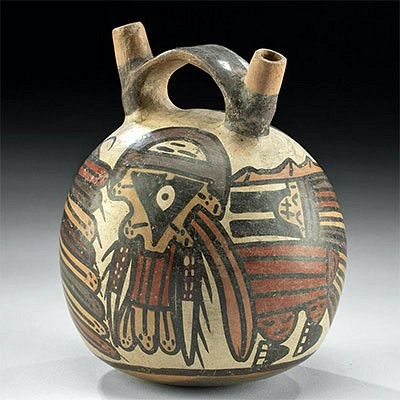2nd C. Gandharan Schist Head of Buddha
Lot 33
About Seller
Artemis Gallery
686 S Taylor Ave, Ste 106
Louisville, CO 80027
United States
Selling antiquities, ancient and ethnographic art online since 1993, Artemis Gallery specializes in Classical Antiquities (Egyptian, Greek, Roman, Near Eastern), Asian, Pre-Columbian, African / Tribal / Oceanographic art. Our extensive inventory includes pottery, stone, metal, wood, glass and textil...Read more
Categories
Estimate:
$400 - $600
Absentee vs Live bid
Two ways to bid:
- Leave a max absentee bid and the platform will bid on your behalf up to your maximum bid during the live auction.
- Bid live during the auction and your bids will be submitted real-time to the auctioneer.
Bid Increments
| Price | Bid Increment |
|---|---|
| $0 | $25 |
| $300 | $50 |
| $1,000 | $100 |
| $2,000 | $250 |
| $5,000 | $500 |
| $10,000 | $1,000 |
| $20,000 | $2,500 |
| $50,000 | $5,000 |
| $100,000 | $10,000 |
| $200,000 | $20,000 |
About Auction
By Artemis Gallery
Feb 10, 2022
Set Reminder
2022-02-10 10:00:00
2022-02-10 10:00:00
America/New_York
Bidsquare
Bidsquare : Ancient & Ethnographic Art Through The Ages
https://www.bidsquare.com/auctions/artemis-gallery/ancient-ethnographic-art-through-the-ages-8873
Join us for Part Two of a spotlight on two fabulous collections, one from Lumberton, Texas, and the other from Whisnant Gallery in New Orleans. Artemis Gallery info@artemisgallery.com
Join us for Part Two of a spotlight on two fabulous collections, one from Lumberton, Texas, and the other from Whisnant Gallery in New Orleans. Artemis Gallery info@artemisgallery.com
- Lot Description
Central Asia, Pakistan, India, and Afghanistan, Gandharan, ca. 2nd to 3rd century CE. A hand-carved miniature grey schist Buddha head, depicted nearly in the round, with a wavy coiffure, a generous ushnisha (topknot) as well as a mesmerizing face that is skillfully modeled with elegant features including almond-shaped, downcast eyes, an arched browline leading to an aquiline nose, and full, closed lips. The drama of this visage with its stylized wavy tresses and meditative expression does not discount its naturalism. Notice how skillfully the sculptor rendered the philtrum (vertical groove in midline above the upper lip), the Cupid's bow of the upper lip, the tear troughs between the eyes and nose, the nasal bridge and nostrils, and the contours of the chin. A wonderful example. Size: 1.6" W x 2.4" H (4.1 cm x 6.1 cm); 4" H (10.2 cm) on included custom stand.
Alexander the Great conquered Gandhara in 330 BCE and with the help of the Indo-Greek kings introduced classical traditions that would influence Gandharan art for the following seven centuries. The stylized curly Mediterranean hair and top knot derive from classical sculptures such as the Apollo Belvedere (330 BCE), and the sensitive modeling of the expressive visage demonstrates a classical influence as well. A rare example of Greco-Buddhist art that demonstrates a strong syncretism between eastern and western traditions.
The head of the Buddha is perhaps the most significant element of the deity as it represents the immense body of knowledge and wisdom of Buddha along with the tranquil nature that emanates from his expression. What's more, in this example the sculptor's adept modeling technique allows for a moving spiritual interpretation as opposed to other comparatively colder, stiffer renderings. A peaceful countenance with a rounded ushnisha symbolizing the wisdom and knowledge acquired after attaining enlightenment, and elongated ears, a physical feature symbolic of the Buddha's time as a prince when he wore elaborate ear ornaments to demonstrate wealth and prosperity. Of course, the prince stopped wearing them when he left the palace to become an ascetic; however, his earlobes remained stretched signifying a conscious decision to reject the material world in exchange for spiritual enlightenment and simultaneously suggest that the Buddha can hear all that is asked for and needed in the earthly world. Those half-closed eyes indicate a meditative state - at once looking both outward and inward. Furthermore, the curled hair of the Buddha signifies the nobility of Buddha. Beyond the multi-layered meaning embodied in the iconography of this piece, the sculptor's artistry and technique is exceptional.
Provenance: private J.H. collection, Beaverton, Oregon, USA
All items legal to buy/sell under U.S. Statute covering cultural patrimony Code 2600, CHAPTER 14, and are guaranteed to be as described or your money back.
A Certificate of Authenticity will accompany all winning bids.
PLEASE NOTE: Due to recent increases of shipments being seized by Australian & German customs (even for items with pre-UNESCO provenance), we will no longer ship most antiquities and ancient Chinese art to Australia & Germany. For categories of items that are acceptable to ship to Australia or Germany, please contact us directly or work with your local customs brokerage firm.
Display stands not described as included/custom in the item description are for photography purposes only and will not be included with the item upon shipping.
#154804The head is a fragment from a larger sculpture and thus the back of the head and the neck are rough and uncarved. Otherwise in good condition with wear commensurate with age and nice preservation of details. Great deposits on surface.Condition
- Shipping Info
-
All shipping is handled in-house for your convenience. Your invoice from Artemis Gallery will include shipping calculation instructions. If in doubt, please inquire BEFORE bidding for estimated shipping costs for individual items.
-
- Buyer's Premium



 EUR
EUR CAD
CAD AUD
AUD GBP
GBP MXN
MXN HKD
HKD CNY
CNY MYR
MYR SEK
SEK SGD
SGD CHF
CHF THB
THB














